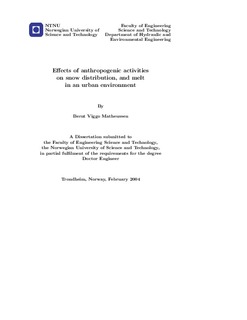| dc.description.abstract | In many parts of the world snow melt runoff influence discharge from combined sewer overflows (CSO) and flooding in urban drainage systems. Despite this, urban snow hydrology is a field that has received little attention from the urban drainage community. The objectives of this research were to better understand urban snow hydrology and through field work and hydrological modelling quantify effects of anthropogenic activities (AA) on snow distribution, and melt in an urban environment. This means in principle how the presence (design geometry) and operation of roads and buildings influence the snow distribution and melt in urban areas. The Risvollan urban catchment (20 ha) located in Trondheim, Norway, was used as a study area. A literature review of urban snow hydrology was also carried out.
A gridded urban hydrology model (GUHM) was developed as part of the study. The principal idea of the GUHM is to subdivide an urban catchment into orthogonal equal area grid cells. The snow routine in the GUHM is based on an energy balance approach, which together with a soil-runoff routine is used to calculate a time series of rain, snow water equivalent (SWE), snow melt, and runoff, for each grid cell. In GUHM, processes such as snow clearing of roads, locally low albedos, heat/shadowing from buildings, and effects of slope and aspect are included in the model structure.
A technique for observing time series of snow covered area (SCA) for an urban catchment is presented. The method is based on image processing and neural network technology to calculate SCA from a time series of images taken from a tall building in the Risvollan catchment. It was shown that SCA on roads and roofs in general becomes more rapidly snow free during melt periods compared to the park areas of the Risvollan catchment. This can be explained by snow clearing of roads, snowdrift from roofs and high snow melt rates on roofs and roads. The high melt rates was attributed to locally low albedos in vicinity to roads, rooftop snow packs exposure to wind and solar radiation, in addition to anthropogenic heat release from the roofs themselves.
Field observations of SWE were carried out in the Risvollan catchment and it was shown that areal mean SWE located on/or nearby roads and buildings were significantly lower during mid and end of the winter, than in park areas. This can be attributed to higher melt rates caused by AA. A time series of SCA and SWE was obtained through field work for the period from 2000 to 2003 in the Risvollan catchment.
The GUHM was applied and calibrated for the Risvollan catchment for a three year period. Two seasons were used as validation period. Comparison between the simulated and observed SWE, SCA and runoff data showed that the GUHM was able to simulate snow accumulation and melt for whole seasons with short time resolution (1 hour) satisfactory.
The GUHM was used to quantify effects of AA on snow distribution and melt for six different land use scenarios in the Risvollan catchment for the period June 1998 to June 2003. The modelling results showed that when the area coverage of buildings and roads increased, the SCA and SWE more rapidly decreased during melt periods. Because of this more runoff will be produced in the early winter season (Jan-March) compared to if the catchment had been covered with only sparsely vegetated areas.
The simulation results showed that when the impervious surface covers of a catchment increase, the peak and volume runoff will also increase, as expected.
Both the field observations and the hydrological model study carried out in this work showed that AA lowers SCA and SWE more rapidly in an urban environment compared to more untouched terrain. The reasons for this are redistribution of snow, and strong snow melt rates on roads, roofs, and in snow deposit areas. Low albedos and anthropogenic heat release are the main reasons for the enhanced snow melt rates. | nb_NO |
